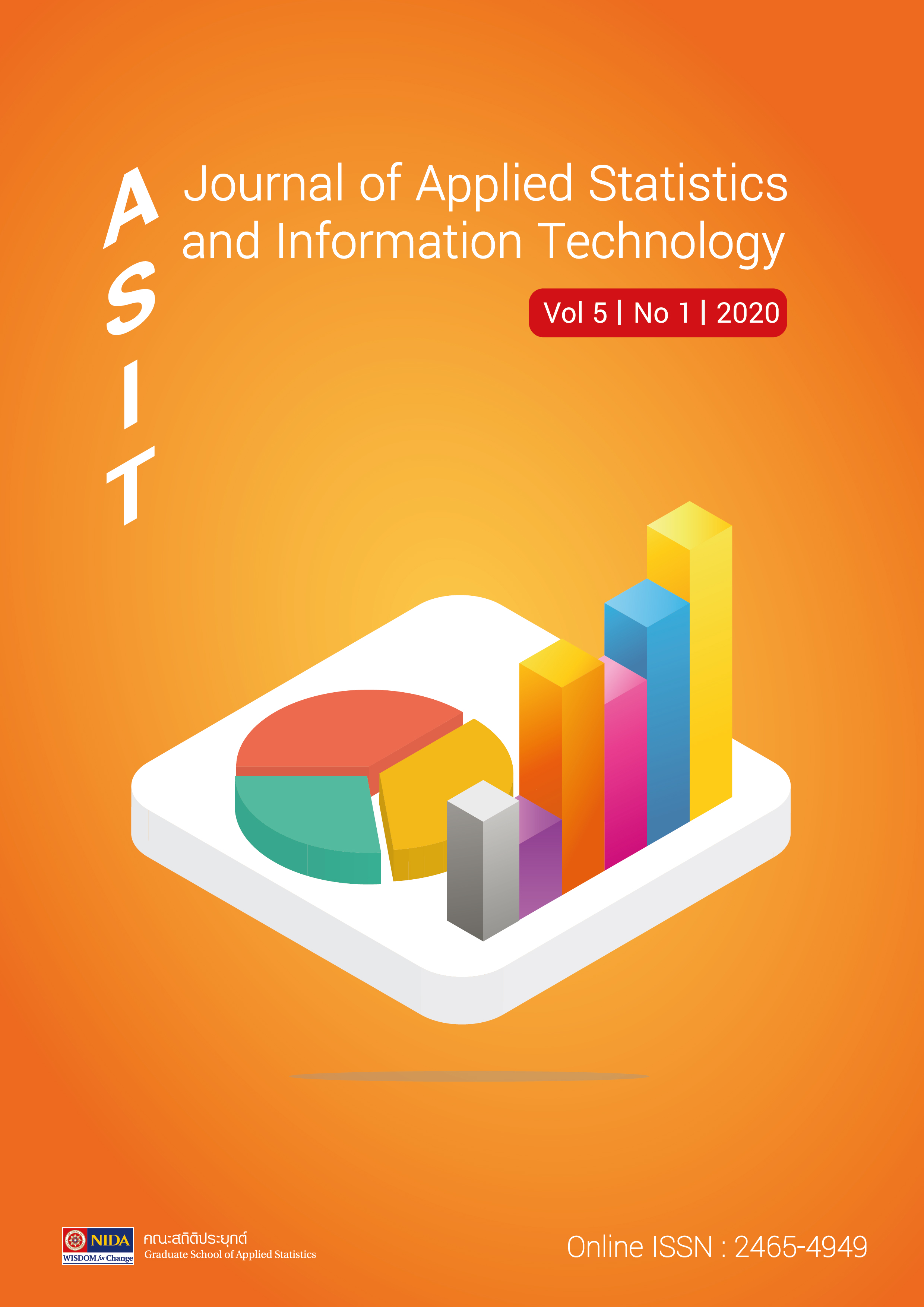Statistical Modeling to Fit Seasonal Rainfall Data from the Doisaket Rain Gauge Station in Thailand
Keywords:
Model selection, Positively skewed, Thai seasonal rainfall data, Gamma regression, Correlated gamma.Abstract
The statistical modeling of Thai seasonal precipitation data is crucial for the effective planning and management of the country’s hydrological operations. There are two aims of this study: 1) to find an appropriate two-parameter statistical distribution to represent seasonal rainfall data from the Doisaket rain gauge station in northern Thailand and 2) to analyze the effect of seasonality on the rainfall data distribution. Two-parameter distributions, namely Weibull, gamma, lognormal, normal, Lindley exponential, and generalized exponential, were used to determine the best-fitting model of seasonal rainfall data from the Doisaket rain gauge station in Thailand. It was found that the gamma distribution with two parameters was the best fit, as indicated by the minimum values for the Akaike information criterion and the Anderson-Darling goodness-of-fit criterion. In addition, gamma regression showed that the precipitation amount during the rainy season affects that in the cold season. The approach and outcomes of this study could be useful for involved government agencies to strategically plan and manage water resources and to effectively prevent rain-related disasters in the Doisaket area.
References
Akaike, H. (1973). Information theory and an extension of the maximum likelihood principle. Proceedings of the 2nd International Symposium on Information Theory, 267 – 281.
Anderson, W., Darling, D.A. (1952). Asymptotic theory of certain “goodness-of-fit” criteria based on stochastic processes. The Annals of Mathematical Statistics, 23(2), 193-212.
Ashkar, F. (2017). Model selection tools for hydrological frequency analysis: some new results. Proceedings of the World Environmental and Water Resources Congress, 384 – 389.
Baldassarre, G.D., Laio, F., Montanari, A. (2009). Design flood estimation using model selection criteria. Physics and Chemistry of the Earth, 34(10-12), 606-611.
Bhati, D., Malik, M.A., Vaman, H.J. (2015). Lindley–exponential distribution: properties and applications. Metron, 73(3), 335-357.
Burnham ,K.P., Anderson, D. (2002). Model selection and multimodel inference. 2nd ed. Berlin-Heidelberg, New York: Springer.
Chaito, T., Khamkong, M. (2018). A modified box and cox power transformation to determine the standardized precipitation index. Songklanakarin Journal of Science and Technology, 40(4), 867-877.
Chaito, T., Khamkong, M., Murnta, P. (2019). Appropriate transformation techniques to determine a modified standardized precipitation index for the Ping River in northern Thailand. EnvironmentAsia, 12(3), 32-42.
Chang,T,P. (2011). Performance comparison of six numerical methods in estimating Weibull parameters for wind energy application. Applied Energy, 88(1), 272-282.
Chaowiwat, W., Sarinnapakprn, K., Boonya-aroonnet, S. (2016). Bias correction of seasonal rainfall forecasts of Thailand from general circulation model by using the ratio of gamma CDF parameter method. Naresuan University Engineering Journal, 11(1), 7-13.
Dey, A.K., Kundu, D. (2009). Discriminating among the log-normal, Weibull and generalized exponential distributions. IEEE Transactions on Reliability, 58(3), 416-424.
Ghitany, M.E., Song, P., Wang, S. (2017). New modified moment estimators for the two-parameter weighted Lindley distribution. Journal of Statistical Computation and Simulation, 87(16), 3225-3240.
Gupta, R.D, Kundu, D. (1999). Generalized exponential distributions. Australian and New Zealand Journal of Statistics, 44(2), 173 - 188
Hussain, T., Bakouch, H.S., Iqbal, Z.A. (2017). New probability model for hydrologic event: properties and applications. Journal of Agricultural. Biological and Environmental Statistics, 23(1), 63-82.
Hydrology and Water Management Center for Upper Northern Region Chiang Mai Thailand. (2015). Bureau of Water Management and Hydrology Royal Irrigation Department Thailand, Rainfall Data [cited 2019 Jul 13] Retrieved from: http://hydro-1.net.
Hydrology Papers no. 8, Colorado State University, Fort Collins, Colorado, USA. (1965). Probability of best fit to distributions of annual precipitation and runoff. [cited 2019 Jul 13] Retrieved from: https://moun tain scholar. org/bitstream/ handle/10217/61285/HydrologyPapers _n8. pdf?sequence=1&isAllowed=y.
Jaithun, M., Khamkong, M. (2017). Optimal parameter estimation for zero-inflated gamma distributions with application to rainfall data of Yom River in northern Thailand. Proceedings of the 13th IMT-GT International Conference on Mathematics, Statistics and their Applications, o50021-1-6.
Khamkong, M., Bookkamana, P. (2015). Development of statistical models for maximum daily rainfall in upper northern region of Thailand. Chiang Mai Journal of Science, 42(4), 1044-1053.
Laio, F., Baldassarre, G.D., Montanari, A. (2009). Model selection techniques for the frequency analysis of hydrological extremes. Water Resources Research, 45(7), 29-40.
Mckee, T.B., Doesken, N.J., Kleist, J. (1993). The relationship of drought frequency and duration on time scale. Proceedings of the 8th Conference on Applied Climatology, 179-184.
Nelder, J.A., Wedderburn, R.W.M. (1972). Generalized linear models. Journal of the Royal Statistical Society: Series A, 1972; 135(3): 370-384.
Pakoksung, K., Takagi, M. (2016). Mixed Zero-Inflation Method and Probability Distribution in Fitting Daily Rainfall Data. Engineering Journal, 21(2), 63-80.
R Core Team. (2015). R: Language and Environment for Statistical Computing. Cited 2019 Jul 13 Retrieved from: https://www.r-project.org/foundation.
Stephens, M.A. (1974). EDF statistics for goodness of fit and some comparisons. Journal of the American Statistical Association, 69(34), 730-737.
Werapun, W., Tirawanichakul, Y., Waewsak, J. (2015). Comparative study of five methods to estimate Weibull parameters for wind speed on Phangan Island, Thailand. Energy Procedia. 79, 976-981.
Yue, S., Hashino, M. (2007). Probability distribution of annual, seasonal and monthly precipitation in Japan. Hydrological Sciences Journal, 52(5), 863 - 877.
Yusof, F., Hui-Mean, F. (2012). Use of statistical distribution for drought analysis. Applied Mathematical Sciences, 6(21), 1031 - 1051.
Downloads
Published
How to Cite
Issue
Section
License
เนื้อหาและข้อมูลที่ปรากฏในบทความที่ตีพิมพ์ในวารสารสถิติประยุกต์และเทคโนโลยีสารสนเทศถือเป็นความคิดเห็นส่วนบุคคลของผู้เขียนแต่ละท่าน ความผิดพลาดของข้อความและผลที่อาจเกิดจากนำข้อความเหล่านั้นไปใช้ผู้เขียนบทความจะเป็นผู้รับผิดชอบแต่เพียงผู้เดียว บทความ ข้อมูล เนื้อหา รูปภาพ ฯลฯ ที่ได้รับการตีพิมพ์ในวารสารถือเป็นลิขสิทธิ์ของวารสาร หากบุคคลหรือหน่วยงานใดต้องการนำทั้งหมดหรือส่วนหนึ่งส่วนใดไปเผยแพร่ต่อหรือเพื่อกระทำการใดๆ จะต้องได้รับอนุญาตเป็นลายลักอักษรณ์จากวารสาร ก่อนเท่านั้น


